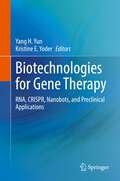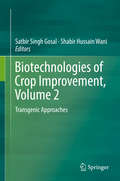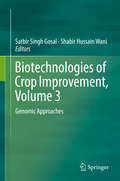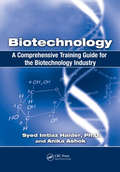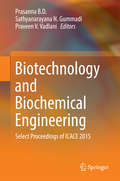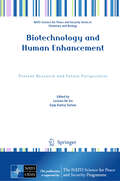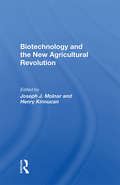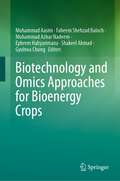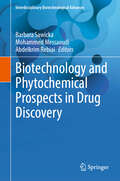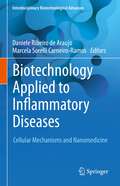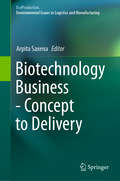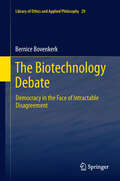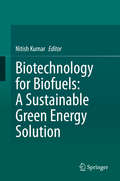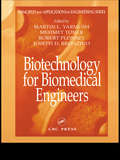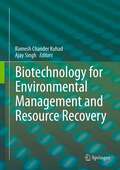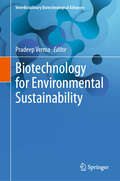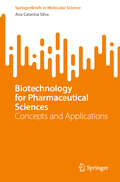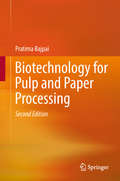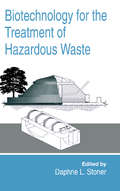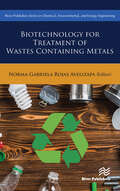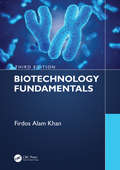- Table View
- List View
Biotechnologies for Gene Therapy: RNA, CRISPR, Nanobots, and Preclinical Applications
by Yang H. Yun Kristine E. YoderThe purpose of this book is to highlight some of latest developments and applications of CRISPR, RNA, and DNA to treat diseases ranging from cancers to cardiovascular and degenerative disorders. It also features innovations of the delivery methods for nucleic acids ranging from nanodevices made from DNA and pseudo amino acids to viral vectors. This is an ideal book for academics, clinicians, and students interested in gene therapy.
Biotechnologies of Crop Improvement, Volume 1: Cellular Approaches
by Satbir Singh Gosal Shabir Hussain WaniDuring the past 15 years, cellular and molecular approaches have emerged as valuable adjuncts to supplement and complement conventional breeding methods for a wide variety of crop plants. Biotechnology increasingly plays a role in the creation, conservation, characterization and utilization of genetic variability for germplasm enhancement. For instance, anther/microspore culture, somaclonal variation, embryo culture and somatic hybridization are being exploited for obtaining incremental improvement in the existing cultivars. In addition, genes that confer insect- and disease-resistance, abiotic stress tolerance, herbicide tolerance and quality traits have been isolated and re-introduced into otherwise sensitive or susceptible species by a variety of transgenic techniques. Together these transformative methodologies grant access to a greater repertoire of genetic diversity as the gene(s) may come from viruses, bacteria, fungi, insects, animals, human beings, unrelated plants or even be artificially derived. Remarkable achievements have been made in the production, characterization, field evaluation and commercialization of transgenic crop varieties worldwide. Likewise, significant advances have been made towards increasing crop yields, improving nutritional quality, enabling crops to be raised under adverse conditions and developing resistance to pests and diseases for sustaining global food and nutritional security. The overarching purpose of this 3-volume work is to summarize the history of crop improvement from a technological perspective but to do so with a forward outlook on further advancement and adaptability to a changing world. Our carefully chosen “case studies of important plant crops” intend to serve a diverse spectrum of audience looking for the right tools to tackle complicated local and global issues.
Biotechnologies of Crop Improvement, Volume 2: Transgenic Approaches
by Satbir Singh Gosal Shabir Hussain WaniDuring the past 15 years, cellular and molecular approaches have emerged as valuable adjuncts to supplement and complement conventional breeding methods for a wide variety of crop plants. Biotechnology increasingly plays a role in the creation, conservation, characterization and utilization of genetic variability for germplasm enhancement. For instance, anther/microspore culture, somaclonal variation, embryo culture and somatic hybridization are being exploited for obtaining incremental improvement in the existing cultivars. In addition, genes that confer insect- and disease-resistance, abiotic stress tolerance, herbicide tolerance and quality traits have been isolated and re-introduced into otherwise sensitive or susceptible species by a variety of transgenic techniques. Together these transformative methodologies grant access to a greater repertoire of genetic diversity as the gene(s) may come from viruses, bacteria, fungi, insects, animals, human beings, unrelated plants or even be artificially derived. Remarkable achievements have been made in the production, characterization, field evaluation and commercialization of transgenic crop varieties worldwide. Likewise, significant advances have been made towards increasing crop yields, improving nutritional quality, enabling crops to be raised under adverse conditions and developing resistance to pests and diseases for sustaining global food and nutritional security. The overarching purpose of this 3-volume work is to summarize the history of crop improvement from a technological perspective but to do so with a forward outlook on further advancement and adaptability to a changing world. Our carefully chosen “case studies of important plant crops” intend to serve a diverse spectrum of audience looking for the right tools to tackle complicated local and global issues.
Biotechnologies of Crop Improvement, Volume 3: Genomic Approaches
by Satbir Singh Gosal Shabir Hussain WaniDuring the past 15 years, cellular and molecular approaches have emerged as valuable adjuncts to supplement and complement conventional breeding methods for a wide variety of crop plants. Biotechnology increasingly plays a role in the creation, conservation, characterization and utilization of genetic variability for germplasm enhancement. For instance, anther/microspore culture, somaclonal variation, embryo culture and somatic hybridization are being exploited for obtaining incremental improvement in the existing cultivars. In addition, genes that confer insect- and disease-resistance, abiotic stress tolerance, herbicide tolerance and quality traits have been isolated and re-introduced into otherwise sensitive or susceptible species by a variety of transgenic techniques. Together these transformative methodologies grant access to a greater repertoire of genetic diversity as the gene(s) may come from viruses, bacteria, fungi, insects, animals, human beings, unrelated plants or even be artificially derived. Remarkable achievements have been made in the production, characterization, field evaluation and commercialization of transgenic crop varieties worldwide. Likewise, significant advances have been made towards increasing crop yields, improving nutritional quality, enabling crops to be raised under adverse conditions and developing resistance to pests and diseases for sustaining global food and nutritional security. The overarching purpose of this 3-volume work is to summarize the history of crop improvement from a technological perspective but to do so with a forward outlook on further advancement and adaptability to a changing world. Our carefully chosen “case studies of important plant crops” intend to serve a diverse spectrum of audience looking for the right tools to tackle complicated local and global issues.
Biotechnology: A Comprehensive Training Guide for the Biotechnology Industry
by Syed Imtiaz Haider Anika AshtokAll manufacturing companies face the daunting task of designing an employee training matrix that meets the gamut of national and international regulatory standards. Answering the call for a one-stop training resource that focuses exclusively on this multi-faceted, high-tech industry, Biotechnology: A Comprehensive Training Guide for the Biotechnology Industry provides ready-to-implement training templates that save time and expense without cutting corners on critical elements.Downloadable Resources: Why Reinvent the Wheel?This complete, single-source reference contains 28 complete biotechnology courses and a customizable downloadable resources with hands-on training tools. The book also provides time-saving information on how to orient employees involved in writing and executing batch manufacturing and in-process control documents.Key Benefits: Contains adaptable training text, test summaries and papers, test answers, and certificates of completion Streamlines the training process, maximizing efficiency Boosts the marketing edge over competitors This valuable training tool presents step-by-step guidance for optimizing research and development expenditures, avoiding marketing delays, gaining a competitive advantage, reducing product development failures, developing skilled manpower, and maintaining local and international regulatory compliance.
Biotechnology, Agriculture, Environment and Energy: Proceedings of the 2014 International Conference on Biotechnology, Agriculture, Environment and Energy (ICBAEE 2014), May 22-23, 2014, Beijing, China.
by Fangli ZhengThe 2014 International Conference on Biotechnology, Agriculture, Environment and Energy (ICBAEE 2014) was held May 22-23, 2014 in Beijing, China. The objective of ICBAEE 2014 was to provide a platform for researchers, engineers, academics as well as industry professionals from all over the world to present their research results and development act
Biotechnology and Biochemical Engineering: Select Proceedings of ICACE 2015
by Prasanna B. D. Sathyanarayana N. Gummadi Praveen V. VadlaniThis book serves to highlight the seamless integration of the sciences leading to sustainable technologies. Chemical engineering is one of the major disciplines catering to the societal needs in the fields of energy, environment and materials. The chapters of this book have been selected to encompass the latest in industrial biotechnology and biochemical engineering principles and applications. The chapters are included here after careful review for content and depth. The book focuses on the relatively new areas of molecular biotechnology and nanotechnology which have a strong impact at the fundamental and process levels in chemical engineering. The book also covers analytical procedures, experimental techniques and process analysis in bioprocessing, bioremediation, green separation methods, and emerging nanoparticle applications. It should be useful to students, academicians, and practitioners alike.
Biotechnology and Communication: The Meta-Technologies of Information (Routledge Communication Series)
by Sandra BramanThis volume examines the convergence of biotechnology and communication systems and explores how this convergence directly influences our understanding of the nature of communication. Editor Sandra Braman brings together scholars to examine this convergence in three areas: genetic information and "facticity"; social issues and implications; and the economic and legal issues raised by the production and ownership of information. The work highlights the sophisticated processes taking place as biotechnology and information technology systems continue to evolve. The chapters in this book approach the complex history of this topic and the issues it raises from a number of directions. It begins by examining the shared features and spaces of biotechnology and digital information technologies as meta-technologies--qualitatively distinct from both the tools first used in the premodern era and the industrial technologies that characterized modernity. Next, the book explores what is and is not useful in treating the types of information processed by the two meta-technologies through a shared conceptual lens and looks at issues raised by the ownership of genetic and digital information. The final chapters are concerned with relationships between information and power. Defining a future research agenda for communication scholarship, this work is beneficial to scholars and students in science communication, cultural studies, information technologies, and sociology.
Biotechnology and Human Enhancement: Present Research and Future Perspectives (NATO Science for Peace and Security Series A: Chemistry and Biology)
by Luciano De Sio Eyup Kuntay TurmusThis book provides new insights in the role that biotechnology and human enhancement will play in the following years to come. Based on the experience and know-how of recognized scientists worldwide, a paradigm shift in advanced technologies is highlighted, merging academic and specialized research centers. Indeed, biotechnology and human enhancement play an essential role in emerging fields such as biosensing, medical technologies, and synthetic biology. These technologies are significant for several cross-disciplinary research activities ranging from medicine to electronics. The book promotes a visionary idea that will establish a more vital collaboration to help track down a roadmap for bringing innovative and breakthrough applications to address the key and emerging challenges for the upcoming years. The book is intended to offer a comprehensive overview for both students and experienced researchers about the main research activities developed in recent years that will help realize a more sustainable approach in modern bio-related applications.
Biotechnology And The New Agricultural Revolution
by Joseph J MolnarThe advent of new methods in shaping the performance characteristics of plants, animals, and microbes dramatically expands the possibilities for advances in agriculture -- a new "Green Revolution" in the offing. This book examines the impact of such developments on agricultural institutions, agribusiness, and farmers: What happens when a fundamenta
Biotechnology and Omics Approaches for Bioenergy Crops
by Muhammad Aasim Faheem Shehzad Baloch Muhammad Azhar Nadeem Ephrem Habyarimana Shakeel Ahmad Gyuhwa ChungThis edited book summarizes the efforts made to develop sustainable bioenergy production through different generations. The topics included in the book cover information about different bioenergy crops, their classification and use as biofuel, agronomic practices to improve biomass yield, classic breeding techniques, genetic diversity, current status and future perspective of bioenergy crops in the omics era. It also discusses application of modern biotechnological and molecular biotechnological techniques for the improvement of bioenergy crops this having enhanced biomass and plant based products. The book explores growing biofuel crops and their impact on environment, bioethics and biosafety issues related to the modern approaches. Another important aspect is the incorporation of nanotechnology for bioenergy crops and biofuel production. All book chapters are contributed renowned researchers in their respective field. This is a unique book covering the bioeneragy crops in the modern omics era. The book is useful for the researchers and post-graduate students to guide them in the field of bioenergy crops.
Biotechnology and Phytochemical Prospects in Drug Discovery (Interdisciplinary Biotechnological Advances)
by Barbara Sawicka Mohammed Messaoudi Abdelkrim RebiaiThis book is a comprehensive exploration of the multifaceted role of phytochemicals in contemporary drug discovery and biotechnology. Comprising eleven insightful chapters, it navigates through the historical roots, current applications, and future possibilities of harnessing plant-derived compounds for medicinal advancements. The initial chapters introduce phytochemicals and their historical significance in traditional medicine, highlighting the scientific validation offered by phytochemistry and pharmacology. The subsequent chapters delve into the incorporation of biotechnology into phytochemical synthesis, focusing on metabolic engineering, synthetic biology, and plant tissue culture to enhance efficiency and reduce environmental impact. The integration of nanomaterial synthesis with medicinal plant extracts is explored for its potential in biomedical applications, such as targeted drug delivery. A thorough examination of bioactive properties of secondary metabolites in unripe fruit extracts reveals their role in immune enhancement, alongside factors affecting bioactive compound content. Advanced analytical techniques crucial to drug discovery are discussed, including "green extraction" and modern methods like high-performance liquid chromatography (HPLC) and gas chromatography (GC) for phytochemical purification and identification. The COVID-19 pandemic has highlighted challenges and strategies in drug discovery, with computational biology advancing molecular target identification and innovative screening methodologies. The exploration of mineral profiling in medicinal plants underscores its importance for human health, detailing methods to identify essential and harmful elements, and noting the nutritional value of these plants. The penultimate chapter addresses future opportunities and challenges in using medicinal plants for drug development, spotlighting India's contributions to global pharmaceutical needs. The final chapter examines phytochemicals as alternative therapeutics against SARS-CoV-2, highlighting antiviral properties and the novel concept of molecular plant farming for vaccine development. This book is a comprehensive resource for those interested in phytochemistry, biotechnology, and pharmacology, elucidating the role of plant-derived chemicals in contemporary medicine and technology.
Biotechnology Applied to Inflammatory Diseases: Cellular Mechanisms and Nanomedicine (Interdisciplinary Biotechnological Advances)
by Daniele Ribeiro de Araujo Marcela Sorelli Carneiro-RamosBiotechnology involves an interdisciplinary science that provides an interface between biological, molecular and cellular aspects of living organisms with broad technologies applicable in the fields of health, environment and materials. This book “Biotechnology applied to inflammatory diseases: Cellular mechanisms and nanomedicine” is focused on elaborating especially on two trendy areas from Biotechnology. In this volume, different inflammatory pathologies in terms of cellular and molecular mechanisms are characterized to better understand the science behind current precision medicine. The second part of the book focuses on the main biotechnological advancements for the understanding of the molecular mechanisms involved in the progression of various types of inflammatory diseases, highlighting up-to-date contributions of nanomedicine. The reader will be able to explore the utilization of technologies for various inflammatory diseases and will be able to enable an engaging and valuable knowledge for further research and clinically applied scenarios.
Biotechnology Business - Concept to Delivery (EcoProduction)
by Arpita SaxenaThis book is an effort to foster the entrepreneurial spirit in young minds. It reviews a wide range of product ideas, opportunities and challenges associated with start-ups. In addition, it discusses popular molecular targets for biotechnology research / the biotech industry such as attenuated microbes, gene sequences, biomarkers, and the latest advance in the sector, CRISPR. These molecular targets can be modified for the production of sufficient quantities of food and fuel. Very often, researchers limit their focus to the proof of concept, and fail to successfully convert it into a finished product. To help young entrepreneurs avoid this pitfall, the book addresses various aspects like intellectual property regulations, commerce and management. The book’s contributing authors hail from various specialized sectors, and from around the globe. Taken together, the respective chapters are intended to overcome the borders between disciplines that otherwise rarely interact.
The Biotechnology Debate
by Bernice BovenkerkThis book grounds deliberative democratic theory in a more refined understanding of deliberative practice, in particular when dealing with intractable moral disagreement regarding novel technologies. While there is an ongoing, vibrant debate about the theoretical merits of deliberative democracy on the one hand, and more recently, empirical studies of specific deliberative exercises have been carried out, these two discussions fail to speak to one another. Debates about animal and plant biotechnology are examined as a paradigmatic case for intractable disagreement in today's pluralistic societies. This examination reveals that the disagreements in this debate are multi-faceted and multi-dimensional and can often be traced to fundamental disagreements about values or worldviews. "One of the acute insights to emerge from this examination is that deliberation can serve different purposes vis-à-vis different types of problem. In the case of deeply unstructured problems, like the modern biotechnology debate, the aim of inclusion is more appropriate than the aim of consensus. This book highlights the importance of political culture and broader institutional settings in shaping the capacity and propensity of citizens to engage in deliberation and the degree to which governments are prepared to relinquish authority to deliberative mini-publics." Robyn Eckersley, University of Melbourne, Australia
Biotechnology, Education and Life Politics: Debating genetic futures from school to society (Routledge Research in Education)
by Pádraig MurphyWhat should individuals and society do when genetic screening becomes widely available and with its impact on current and future generations still uncertain? How can our education systems around the world respond to these developments? Reproductive and genetic technologies (RGTs) are increasingly controversial and political. We are entering an era where we can design future humans, firstly, by genetic screening of "undesirable" traits or indeed embryos, but perhaps later by more radical genetic engineering. This has a profound effect on what we see as normal, acceptable and responsible. This book argues that these urgent and biopolitical issues should be central to how biology is taught as a subject. Debate about life itself has always been at the forefront of connected molecular, genetic and social/personal identity levels, and each of these levels requires processes of communication and debate, what Anthony Giddens called in passing life politics. In this book Pádraig Murphy opens the term up, with examples from field research in schools, student responses to educational films exploring the future of RGTs, and science studies of strategic biotechnology and the lab practices of genetic screening. Life political debate is thoroughly examined and is identified as a way of connecting mainstream education of biology with future generations. Biotechnology, Education and Life Politics will appeal to post-graduates and academics involved with science education, science communication, communication studies and the sociology of education.
Biotechnology for Biofuels: A Sustainable Green Energy Solution
by Nitish KumarThe depletion of petroleum-derived fuel and environmental concerns have prompted many millennials to consider biofuels as alternative fuel sources. But completely replacing petroleum-derived fuels with biofuels is currently impossible in terms of production capacity and engine compatibility. Nevertheless, the marginal replacement of diesel with biofuel could delay the depletion of petroleum resources and abate the radical climate change caused by automotive pollutants. Energy security and climate change are the two major driving forces for worldwide biofuel development, and also have the potential to stimulate the agro-industry. The development of biofuels as alternative and renewable sources of energy has become critical in national efforts towards maximum self-reliance, the cornerstone of our energy security strategy. At the same time, the production of biofuels from various types of biomass such as plants, microbes, algae and fungi is now an ecologically viable and sustainable option. This book describes the biotechnological advances in biofuel production from various sources, while also providing essential information on the genetic improvement of biofuel sources at both the conventional and genomic level. These innovations and the corresponding methodologies are explained in detail.
Biotechnology for Biomedical Engineers (Principles and Applications in Engineering)
by Martin L. Yarmush Mehmet Toner Robert Plonsey Joseph D. BronzinoWith the advent of recombinant DNA technology, monoclonal antibody technology, and new technologies for studying and handling cells and tissues, the field of biotechnology has undergone a tremendous resurgence in a wide range of applications pertinent to industry, medicine, and science in general. A volume in the Principles and Applications in Engi
Biotechnology for Environmental Management and Resource Recovery
by Ajay Singh Ramesh Chander KuhadVarious types of secondary agriculture and forestry wastes represent valuable resource materials for developing alternate energy as biofuels and other value added products such as sugars, phenols, furans, organic acids, enzymes and digestible animal feed etc. However, if not managed properly, waste material and environmental contaminants generated by various industries such as food and feed, pulp and paper and textile may lead to severe environmental pollution. The energy, food and feed demand necessitate developing simple and economically viable technologies for environmental management and resource recovery. Microorganisms and their enzymes contribute significantly in utilization of plant residues, resource recovery and eventually in pollution mitigation. "Biotechnology for Environmental Management and Resource Recovery" presents a comprehensive review of selected research topics in a compendium of 16 chapters related to environmental pollution control and developing biotechnologies in agro-ecosystem management and bioconversion of agro-residues (lignocellulosics) into biofuels, animal feed and paper etc. This book provides a valuable resource for reference and text material to graduate and postgraduate students, researchers, scientists working in the area of microbiology, biotechnology, and environmental science and engineering.
Biotechnology for Environmental Sustainability (Interdisciplinary Biotechnological Advances)
by Pradeep VermaThis book covers the broader application of environmental biotechnology for protecting the environment through different bioremediation and biodegradation techniques framed toward removing environmental contaminants, including emerging contaminants. The extensive range of environmental pollutants, which may be organic or inorganic, including toxic heavy metals, radionuclides, synthetic organic dyes, organic compounds, endocrine-disrupting chemicals, pharmaceuticals, and personal care products, etc., continue to pose a threat to human health and ecosystem functioning. The book covers a comprehensive overview of environmental pollutants, including their fate, behavior, and environmental and health risks associated with them. It describes the utilization of bioremediation and phytoremediation processes to provide a superior alternative removal and detoxification of such toxic environmental pollutants directed toward managing ecosystems. It includes an overview of gene modification and omics technology for environment management for the aesthetic approaches to environmental clean-up. Moreover, the book discusses resource recovery from waste using such technologies, which increases the feasibility of the process. Additionally, the book is designed to provide awareness among its readers about major environmental issues like pollution and its management and control through biotechnological means to promote the sustainable development of our society with minimal environmental impact. It also provides technical content regarding the mechanism of bioremediation, biodegradation, and phytoremediation and their field applicability, along with an overview of emerging pollutants and gene modification techniques for remediation applications.
Biotechnology for Pharmaceutical Sciences: Concepts and Applications (SpringerBriefs in Molecular Science)
by Ana Catarina SilvaThis book provides a compact and straightforward overview of the main concepts and applications of Pharmaceutical Biotechnology. The author collates lecture notes on Pharmaceutical Biotechnology to introduce the topic to graduate students in the fields of Pharmaceutical Sciences, Biochemistry, Biotechnology and Industrial Biotechnology, Microbiology, and Medicinal Chemistry. The book starts with an overview of the biotechnological processes needed to develop biological and biosimilar medicines. Next, the author addresses the development and use of advanced therapy medicinal products (ATMPs), including topics such as cell and gene therapies, regenerative medicine and the regulatory issues of biological medicines and ATMPs. Finally, the author explores the limitations of administering biopharmaceuticals, discussing protein and nucleic acid stability issues, potential routes of administration and strategies for improving the bioavailability of biologics and ATMPs. This book captures the latest developments in the field and offers a practical perspective on the topic, serving as a valuable introduction resource not only for graduate students but also for researchers. The basis of the English translation of this book, originally in Portuguese, was facilitated by artificial intelligence. The content was later revised by the author for accuracy.
Biotechnology for Pulp and Paper Processing
by Pratima BajpaiThe book provides the most up-to-date information available on various biotechnological processes useful in the pulp and paper industry. The first edition was published in 2011, covering a specific biotechnological process or technique, discussing the advantages, limitations, and prospects of the most important and popular processes used in the industry. Many new developments have taken place in the last five years, warranting a second edition on this topic. The new edition contains about 35% new material covering topics in Laccase application in fibreboard; biotechnology in forestry; pectinases in papermaking; stickies control with pectinase; products from hemicelluloses; value added products from biorefinery lignin; use of enzymes in mechanical pulping.
Biotechnology for the Treatment of Hazardous Waste
by Daphne L. StonerThe development of biologically based processes for the treatment of hazardous inorganic and organic wastes is a multi-disciplinary effort requiring the consideration of a number of biological, chemical, and physical parameters, as well as the effective teaming of biologists, chemists, engineers, and regulatory agencies. This new text/reference bridges the disciplines in a unique way, allowing an exchange of fundamental information to take place. The book begins with a description of the biological transformations of inorganic and organic compounds and a review of strategies that may be used for the treatment of hazardous wastes. It continues with a discussion of the physiological and engineering factors that must be considered for successful process development and concludes with a discussion of the regulations that have influenced biological waste treatment and environmental remediation.
Biotechnology for Treatment of Residual Wastes Containing Metals
by Norma Gabriela Rojas-AvelizapaBiotechnology for Treatment of Wastes Containing Metals addresses various aspects related to different wastes that have a metallic content and represent a serious risk for the environment and human health. These wastes, due to their physical and chemical characteristics, have been the object of studies which have led to the development of different technologies in recycling, reuse or adequate disposal, biotechnology being one of these alternatives. Biotechnology offers a range of options for the treatment of types of waste using microorganisms, biomass and their by-products. The mechanisms involved in these waste treatment processes are diverse and complex, and its optimization and efficiency is multifactorial.This text contains nine chapters related to the problem of the metal contamination in the environment as well as some of the different biotechnological alternatives that have been applied for the reduction and/or recovery of metal contamination.
Biotechnology Fundamentals Third Edition
by Firdos Alam KhanAfter successful launching of first and second editions of Biotechnology Fundamentals, we thought let us find out the feedbacks from our esteemed readers, faculty members, and students about their experiences and after receiving their suggestions and recommendation we thought it would be great idea to write 3rd edition of the book. Being a teacher of biotechnology, I always wanted a book which covers all aspects of biotechnology, right from basics to applied and industrial levels. In our previous editions, we have included all topics of biotechnology which are important and fundamentals for students learning. One of the important highlights of the book that it has dedicated chapter for the career aspects of biotechnology and you may agree that many students eager to know what are career prospects they have in biotechnology. There are a great number of textbooks available that deal with molecular biotechnology, microbial biotechnology, industrial biotechnology, agricultural biotechnology, medical biotechnology, or animal biotechnology independently; however, there is not a single book available that deals with all aspects of biotechnology in one book. Today the field of biotechnology is moving with lightening speed. It becomes very important to keep track of all those new information which affect the biotechnology field directly or indirectly. In this book, I have tried to include all the topics which are directly or indirectly related to fields of biotechnology. The book discusses both conventional and modern aspects of biotechnology with suitable examples and gives the impression that the field of biotechnology is there for ages with different names; you may call them plant breeding, cheese making, in vitro fertilization, alcohol fermentation is all the fruits of biotechnology. The primary aim of this book is to help the students to learn biotechnology with classical and modern approaches and take them from basic information to complex topics. There is a total of 21 chapters in this textbook covering topics ranging from an introduction to biotechnology, genes to genomics, protein to proteomics, recombinant DNA technology, microbial biotechnology, agricultural biotechnology, animal biotechnology, environmental biotechnology, medical biotechnology, nanobiotechnology, product development in biotechnology, industrial biotechnology, forensic science, regenerative medicine, biosimialars, synthetic biology, biomedical engineering, computational biology, ethics in biotechnology, careers in biotechnology, and laboratory tutorials. All chapters begin with a brief summary followed by text with suitable examples. Each chapter illustrated by simple line diagrams, pictures, and tables. Each chapter concludes with a question session, assignment, and field trip information. I have included laboratory tutorials as a separate chapter to expose the students to various laboratory techniques and laboratory protocols. This practical information would be an added advantage to the students while they learn the theoretical aspects of biotechnology.
